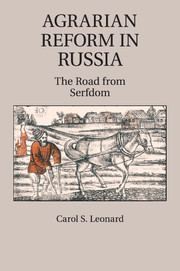Book contents
- Frontmatter
- Contents
- Tables and Figures
- Preface
- Agrarian Reform in Russia
- Introduction
- PART I DILEMMAS OF AGRARIAN REFORM IN RUSSIA
- PART II RUSSIAN LAW AND RURAL ORGANIZATION, 1861–2010
- PART III RUSSIAN AGRICULTURAL PERFORMANCE, 1861–2010
- 6 Technology and Farming Culture
- 7 Reform and Long-Run Productivity Growth, 1861–2010
- Conclusion: The Present from the Perspective of the Past
- APPENDICES
- References
- Index
7 - Reform and Long-Run Productivity Growth, 1861–2010
Published online by Cambridge University Press: 01 June 2011
- Frontmatter
- Contents
- Tables and Figures
- Preface
- Agrarian Reform in Russia
- Introduction
- PART I DILEMMAS OF AGRARIAN REFORM IN RUSSIA
- PART II RUSSIAN LAW AND RURAL ORGANIZATION, 1861–2010
- PART III RUSSIAN AGRICULTURAL PERFORMANCE, 1861–2010
- 6 Technology and Farming Culture
- 7 Reform and Long-Run Productivity Growth, 1861–2010
- Conclusion: The Present from the Perspective of the Past
- APPENDICES
- References
- Index
Summary
INTRODUCTION
Were Russia's agrarian institutions resistant to change in periods following reform? One way to address this question is by examining the numbers: what information do indicators of agricultural performance provide about rates of change before and after reforms? By assessing institutional response one may ask, for example, was the second major reform as necessary as it seemed to Stolypin? That is, were Russia's transformed agrarian institutions after serf emancipation adjustable and effectively responding to markets? Using total factor productivity (TFP) as the main performance indicator, this chapter presents new evidence for the tsarist period and reviews published estimates for the Soviet and post-Soviet eras to assess the pace of change over the short and long run.
The annual rate of change in TFP is used here because it is comparable over time – a valuable quality for such different regimes – and it is revealing of the potential of skills, new knowledge and organizational change to bring about improvements in the sector. Positive agricultural TFP growth lowers food prices, thereby stabilizing welfare as economies grow, while releasing resources for use in more productive sectors and bringing capital into the country via exports of grain. Partial factor productivities – the ratio of total output to a single input, generally land or labor, can be used when there is concern with specific processes. The productivity of labor and land, for example, can be estimated by using, respectively, labor-hours and sown acreage as input variables in the ratio with output.
- Type
- Chapter
- Information
- Agrarian Reform in RussiaThe Road from Serfdom, pp. 225 - 255Publisher: Cambridge University PressPrint publication year: 2010

